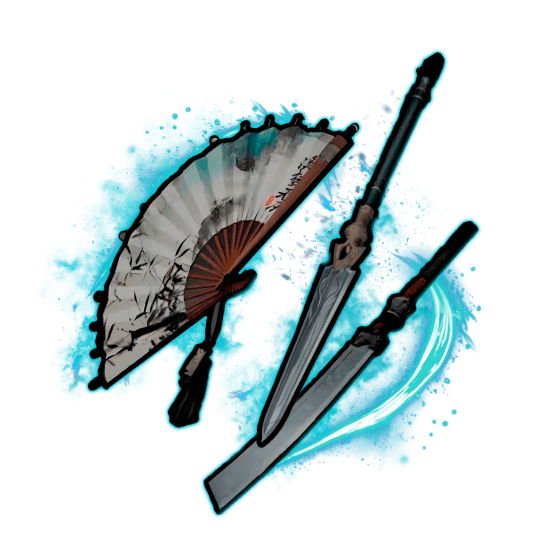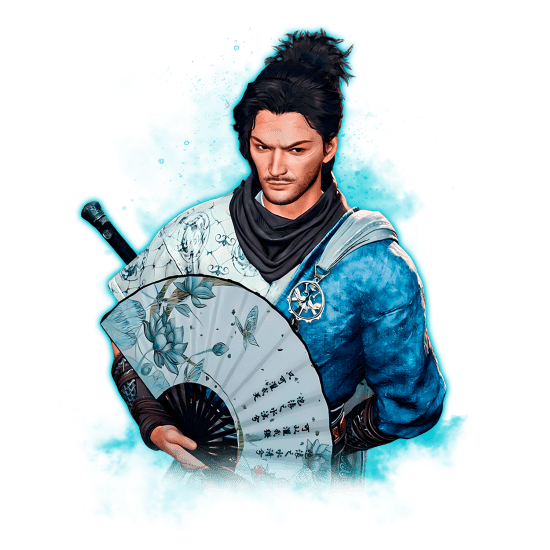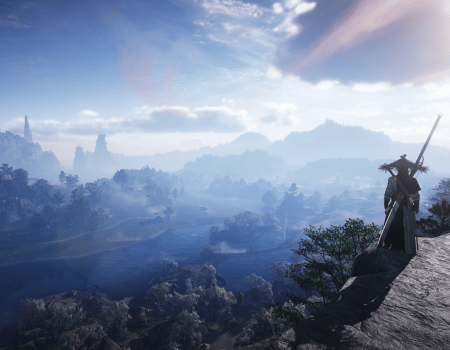In this guide, we’re going to list Where Winds Meet best builds and explain why each one works so well. The game gives you a lot of freedom, but it also mixes traditional MMO roles with its own unusual systems, which makes it hard to understand what actually defines a build. Weapon variations, mystic arts, internal passives, and path identities all interact in ways the game never clearly teaches. This guide cuts through that confusion by breaking down five strong builds that cover every major role, use weapon pairs you can access early, and match both official path design and community-tested performance. No matter how you prefer to play, you’ll find a build here that feels powerful, clear, and easy to grow with.
Do you want to get access to all talents, Inner Paths, and weapon variations? Buy Where Winds Meet Powerleveling at Skycoach and skip dozens of hours of grinding. Unlock new traversal and combat abilities and enjoy the game the way it was made to be enjoyed!
Read our other Where Winds Meet guides:
Note: At Skycoach, you can Buy Where Winds Meet Boost at the best prices with fast delivery. Use our special PROMO CODE (in green) hidden in this article for a 20% DISCOUNT.
What Makes a Build in Where Winds Meet
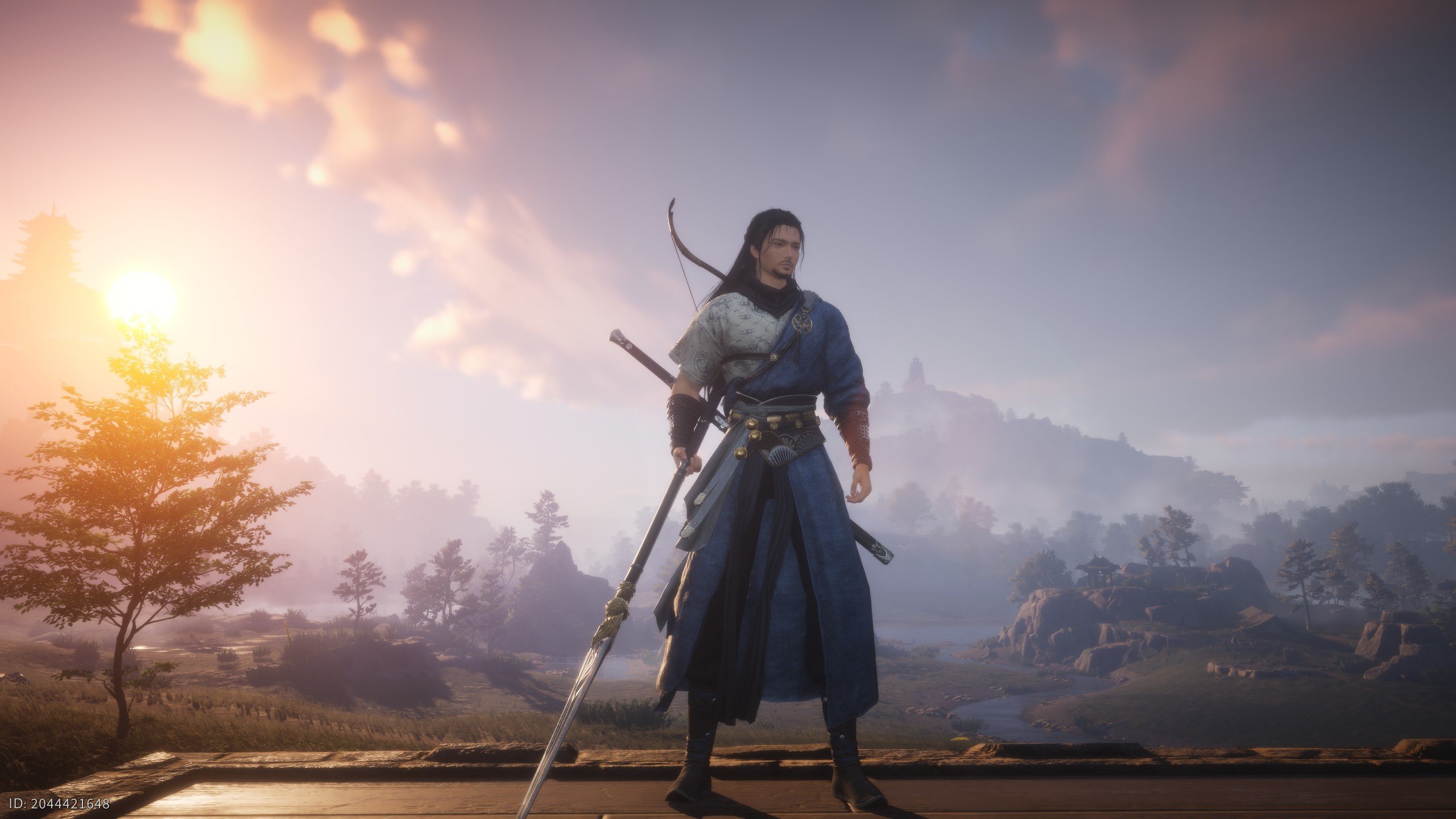
I’d like to start Where Winds Meet best builds guide by explaining how builds work based on my time with the game. There are classic MMO roles like DPS, tank, and healer, but the systems behind those roles are presented in such an unusual way that it can be hard to understand what actually counts as a build. Instead of one clear menu, the game spreads core features across several different screens. To make things simple, here are the components that form a complete build and how each one fits into your character’s combat identity.
Weapons
A build always starts with your two equipped weapons. Each weapon has its own martial art style, and many have multiple variants that completely change how they behave. These two weapons define your role and your core playstyle.
Mystic Arts
You can equip up to four Mystic Arts. These are your active abilities that add mobility, control, damage, or utility. They shape how your build feels in real combat and help you cover weaknesses in your weapon kit.
Internal Arts
These are passive effects that activate during combat. Some work with any weapon, while others are tied to specific martial arts. You can equip four at a time, and they reinforce your preferred style with bonuses like extra healing, damage boosts, resource refunds, or weapon-specific triggers.
Gear
Your ten gear slots provide the stats your build needs to function well. You don’t need exact item names to understand this layer, because the important part is the stat focus: damage stats for DPS, defensive stats for tanks, and Dew or healing bonuses for support.
Martial Path
Each weapon pair belongs to one of the game’s official Martial Paths, such as Wind, Splendor, or Deluge. These paths represent the intended role of the build and offer guidance on which weapons and abilities naturally work well together.
These five elements form the best builds in Where Winds Meet, and each one plays a clear part in shaping your character’s strengths. With these basics in mind, we can move into the best builds available right now.
Bellstrike Splendor – Starter Melee DPS (Nameless Sword + Nameless Spear)
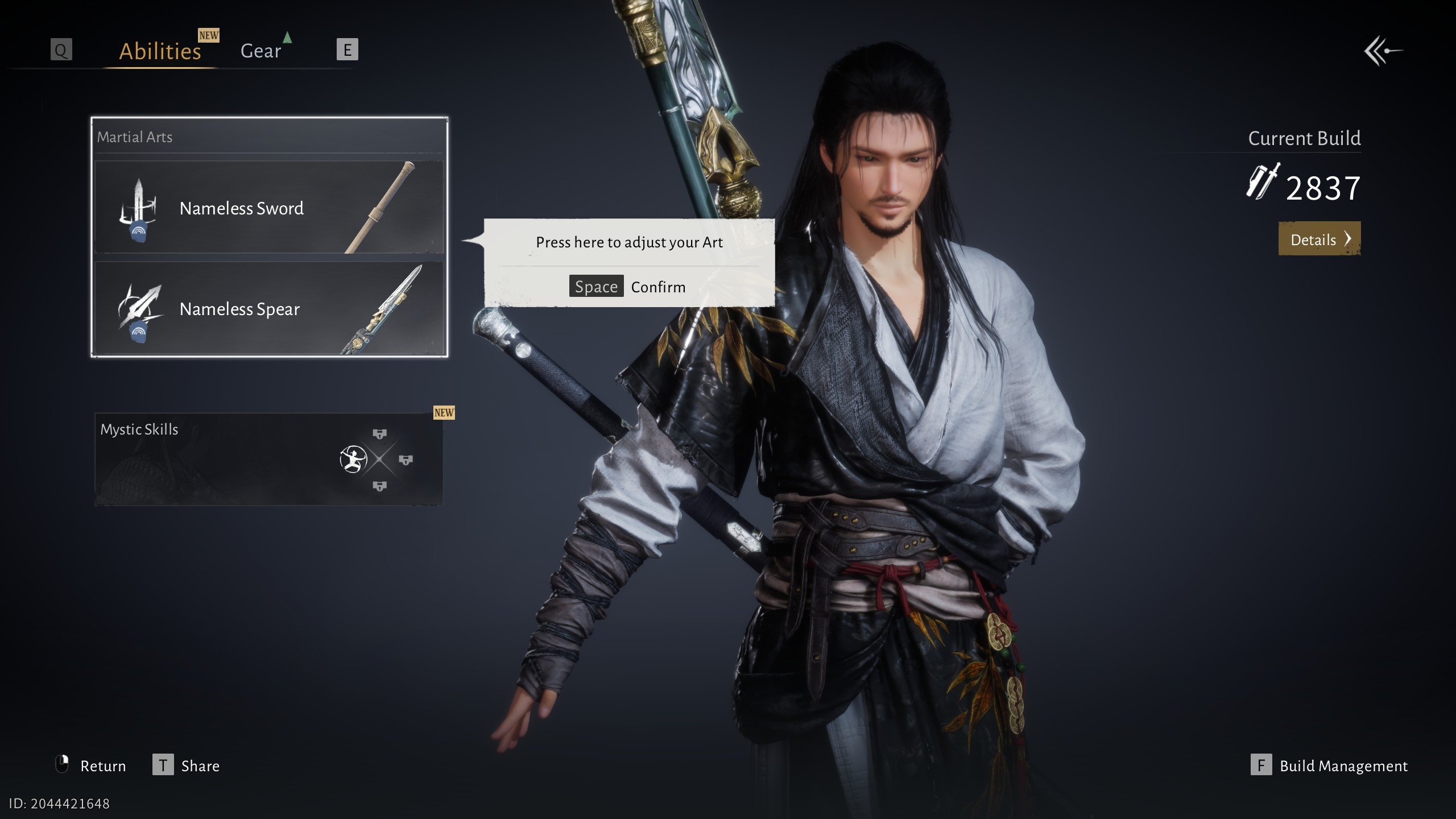
This is the easiest and most reliable melee DPS build in the game. It might not make it in the Where Winds Meet builds meta for the endgame, but it's a solid start for new players. It uses the two weapons you unlock during the opening sequence, and the Splendor path gives you steady damage, safe gap closers, and a smooth tempo that works perfectly for new players. You get strong charged attacks, simple mobility, and enough control to handle both bosses and open-world enemies without complicated setups. BLOG20
Weapons
These are actually the first two weapons you get in the game. You start with the Nameless Sword, and you get the Spear right at the beginning
- Nameless Sword - has strong charged attack that hits hard even with low investment. The ability. Daunting Striker is the natural gap closer and retreat built into the same ability. Besides its a very simple weapon to learn for new players
- Nameless Spear - can stun your target with Quiankun’s Lock for free hits. Besides, its still a fast melee weapon that can damage multiple enemies. Plus it has a projectile-immune heavy attack that gives you safe trades
These two weapons work together because the sword handles your burst and mobility, while the spear gives you range, rooting, and defensive stability. You start fights with the sword when you want to move fast, and switch to the spear whenever you need space or guaranteed openings.
Recommended Mystic Arts
This build focuses on straightforward damage, mobility, and crowd control. All the Mystic Arts below come directly from your screenshots and fit naturally into Splendor’s melee flow.
- Flaming Meteor – a charge-in strike that ends with an AoE explosion and gives Damage Reduction and Super Armor.
- Guardian Palm – a simple ground-slam that deals AoE damage and upgrades when used at height.
- Leaping Toad – a flip-back knockback into a lunge, letting you retreat then immediately re-engage.
- Ghost Bind – immobilizes up to six targets and breaks Vital Spots for safe follow-ups.
- Cloud Steps – lets you stomp enemies from above and gives mobility and disruption in melee.
These provide a complete toolkit: mobility, AoE, control, and safety for any encounter type.
Best Arsenal Path
Bellstrike – Splendor is the intended path for the Nameless Sword and is shown directly on its weapon page. Splendor emphasizes straightforward melee damage, strong basic skill uptime, and forgiving Endurance usage. For early solo progression this is the smoothest and most stable option.
Best Inner Ways
- Early melee-enhancing Inner Ways
- Anything that increases Endurance recovery
- Basic survivability passives such as HP or minor damage reduction
If you later unlock Splendor-specific Inner Ways, choose the ones that increase External Attack or improve charged attacks.
Stat Recommendations
You should prioritize External Attack and Penetration whenever possible, since both directly boost your sword and spear damage. Early armor pieces that add HP or Defense help while you learn timing, and any accessory or gear upgrade that increases Endurance usage or reduces cooldowns will make Shadow Step and Qian Kun’s Lock easier to use repeatedly.
Bellstrike Umbra – Bleed Melee DPS (Strategic Sword + Heavenquaker Spear)
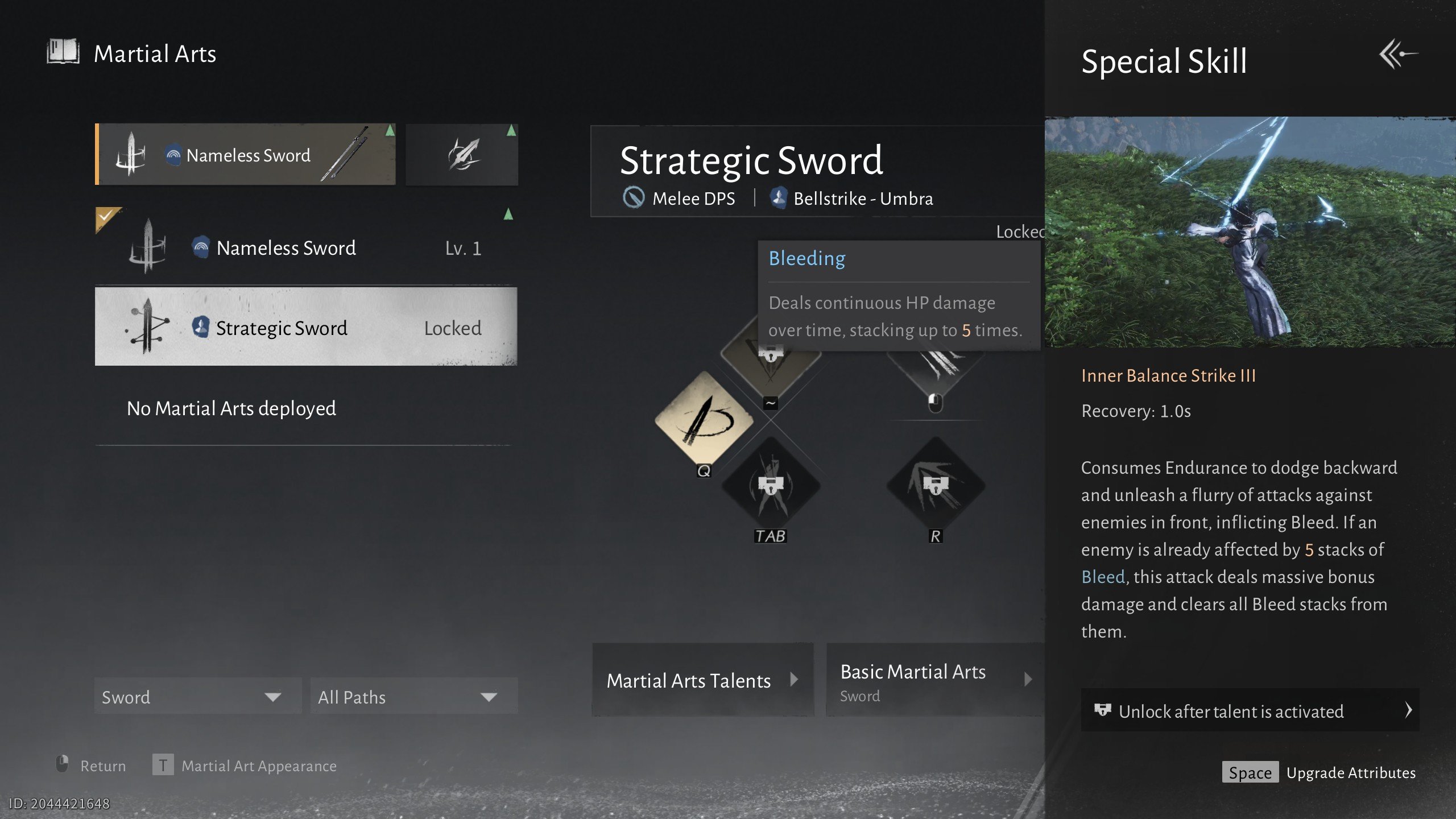
This top Where Winds Meet DPS build focuses on raw burst damage and bleed stacking. It becomes available once you unlock your first advanced sword variant and a spear with stronger control tools. Umbra emphasizes aggressive melee pressure, fast skill windows, and high payoff when you maintain Bleed stacks correctly. It is the natural upgrade from Splendor once you want more damage and a faster combat rhythm.
Weapons
This pairing revolves around building Bleed with the Strategic Sword and then using the spear to keep enemies locked in place long enough for your burst skills to land cleanly.
- Strategic Sword - Inner Balance Strike III is the defining Special Skill. It inflicts Bleed and escalates up to five stacks, then consumes all stacks for a massive finisher if you use the skill again. This creates one of the strongest early-game burst windows. The sword also has smooth basic attacks that keep you close to your target while you build stacks.
- Heavenquaker Spear - The spear assists with control and spacing. You use its immobilizing skills to stop enemies from escaping while your Bleed stacks tick. It also helps start a combo from mid-range, letting you transition back into your sword without losing pressure. Its reach and defensive options give you consistency when targets dodge or shield.
Together, these weapons create a clean loop: build Bleed with the sword, lock enemies with the spear, then finish with Inner Balance Strike when the stacks are full.
Mystic Arts
Umbra uses fast melee pressure and short but explosive burst windows. Since you can only equip four Mystic Arts at once, start with a core set that supports control, mobility, and safe openings. The remaining options are alternates you can switch to when needed.
Recommended main set (equip these four):
- Ghost Bind – Immobilizes up to six enemies and breaks Vital Spots, giving you a guaranteed window to apply or consume Bleed stacks.
- Leaping Toad – Knockback into a forward lunge helps you secure distance or re-engage before using Inner Balance Strike III.
- Flaming Meteor – A strong engage tool with AoE damage, Super Armor, and Damage Reduction for safe Bleed stacking.
- Cloud Steps – Offers fast vertical movement and stomps, helping you dodge attacks and stay close to the target.
Optional swap-ins (switch depending on encounter):
- Guardian Palm – Simple AoE slam for crowd control and space creation when surrounded.
Use one optional skill based on what type of content you’re doing, rotating it in as needed. This keeps the build flexible without overcomplicating your combat bar.
Best Arsenal Path
Bellstrike – Umbra is the path listed directly on the Strategic Sword and is designed around Bleed stacking. It improves your burst windows, supports aggressive melee chains, and rewards tight execution. Once you begin unlocking Umbra enhancements, this becomes a major jump in damage over Splendor.
Best Inner Ways
- Passives that boost Bleed damage
- Passives that enhance Special Skill damage
- Any melee-focused Inner Way that increases crit chance or shortens recovery on dodge skills
If you later acquire Umbra-specific inner passives, prioritize those tied to Bleed upkeep and consumption.
Stat Recommendations
Aim for External Attack and Crit to amplify your burst windows. Penetration is valuable for difficult enemies since Bleed damage is supplemented heavily by your finisher. Gear with added Endurance or Endurance recovery also helps, as Inner Balance Strike consumes Endurance to activate. Early armor with HP and Defense remains useful while learning timing and stack management.
Bamboocut Wind – Melee DPS (Infernal Twinblades + Mortal Rope Dart)

This best DPS build Where Winds Meet focuses on fast-paced melee combat with constant movement, rapid target switching, and aggressive pressure. Wind is built around speed, crit-heavy damage, and momentum. The Infernal Twinblades supply quick multi-hit strings that scale well with stacking effects, and the Mortal Rope Dart gives you powerful mobility, reach, and crowd control. Together, they create a fast assassin-style playstyle that excels in open-world content and mobile boss fights.
Weapons
This weapon pairing revolves around speed and smooth transitions. You open fights, reposition, and pressure enemies with Twinblades, then switch to the Rope Dart whenever you need control, a gap closer, or quick burst setups.
- Infernal Twinblades - Fast consecutive hits define the twinblade style. The quick light strings make it easy to stagger weaker enemies, and the constant flurry of strikes gives you reliable pressure. This speed lets you take advantage of Wind-scaling bonuses and any stacking effects you unlock later.
- Mortal Rope Dart - This weapon gives you mid-range reach, group control, and directional mobility. Its forward pull-style skills let you instantly close distance or reposition behind enemies. Rope Dart transitions cleanly into Twinblade strings and helps you reset or re-engage without losing tempo.
Twinblades build momentum, while the Rope Dart secures targets and keeps you glued to them, making this one of the smoothest and fastest melee combinations available early on.
Mystic Arts
Wind thrives on rapid movement and fast attacks, so your Mystic Art bar should focus on mobility, quick openings, and control. You can only equip four skills at once, so here is the optimal primary set based on your screenshots:
Recommended main set (equip these four):
- Cloud Steps – Excellent for jumping into or out of danger while still dealing damage. Fits perfectly into a fast melee rhythm.
- Leaping Toad – Retreat + lunge for quick reposition or chase-down. Works extremely well when weaving between weapons.
- Flaming Meteor – Strong engage tool with Super Armor and AoE damage that lets you force openings safely.
- Ghost Bind – Immobilizes up to six targets and breaks Vital Spots. This is your best way to lock enemies in place before switching to Twinblades for a burst window.
Optional swap-in:
- Guardian Palm if you want an extra AoE slam for clearing groups or resetting space in dungeons.
These Mystic Arts maintain the Wind identity of mobility, pressure, and clean combo extension.
Best Arsenal Path
Bamboocut – Wind is the path tied directly to the Twinblades and Rope Dart. It supports the build’s strengths: faster attack cadence, crit scaling, movement speed, and smoother transitions between hits. This path turns your mobility into consistent DPS and helps your multi-hit combos hit harder, especially when you start getting Wind-related passives.
Best Inner Ways
- Passives that increase crit rate or crit damage
- Faster Endurance recovery for more dodges and movement
- Universal damage-over-time passives such as bleed or poison
- Any melee bonus that scales with consecutive hits
Even with only early-game Inner Ways, Wind benefits greatly from anything that rewards fast attacks or improves your ability to stay in motion.
Stat Recommendations
Look for External Attack and Critical Rate first, since fast weapons gain the most from flat DPS boosts. Penetration is useful for boss fights and tougher armored enemies. Extra Endurance or Endurance efficiency makes the build feel smoother because you rely heavily on dodging, repositioning, and mobility chains. If you find accessories with movement speed or skill cooldowns, they fit naturally into Wind’s tempo.
Silkbind Jade – Ranged DPS (Ninefold Umbrella + Inkwell Fan)
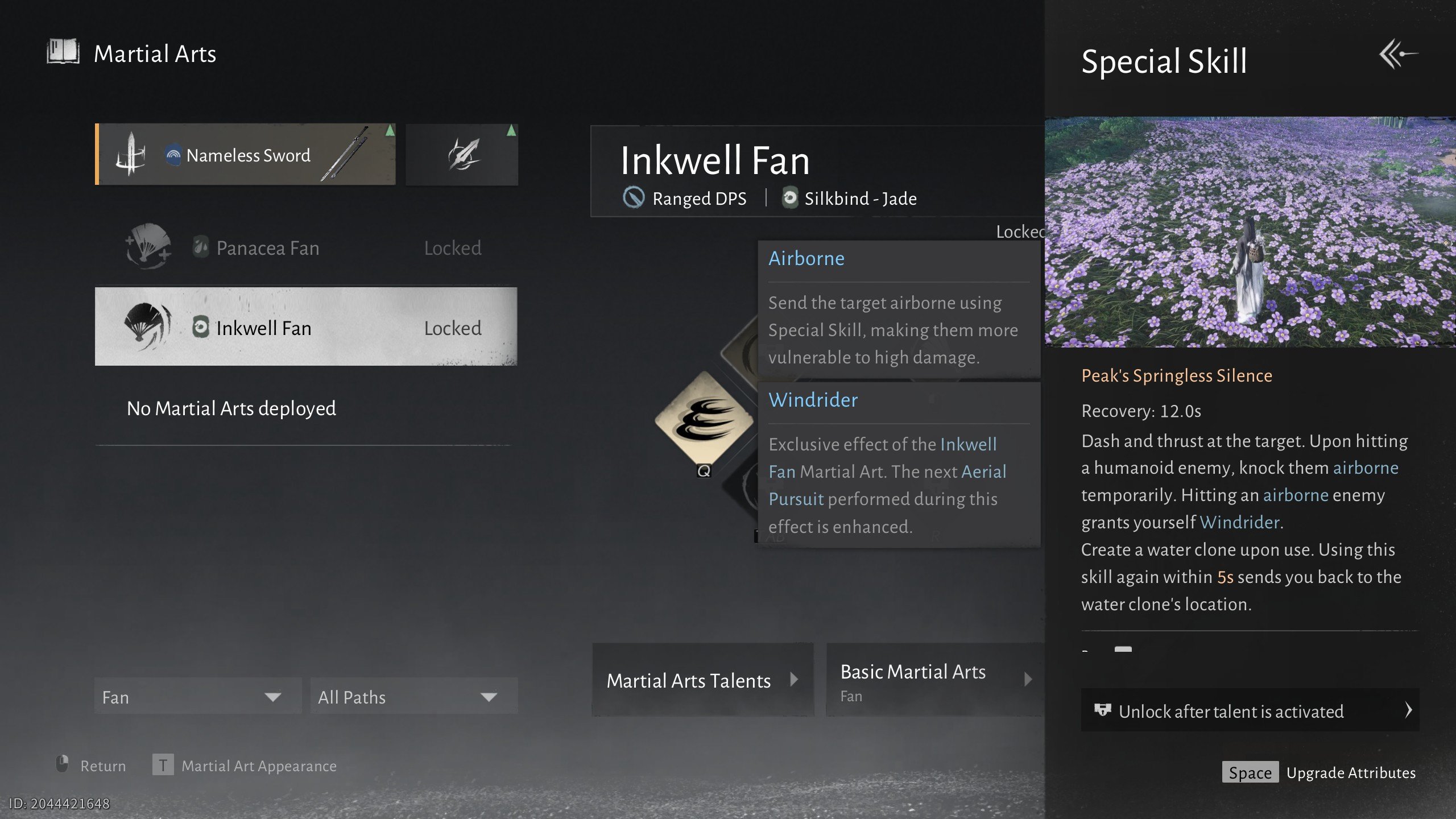
This build focuses on high-speed ranged damage, strong mobility, and constant pressure from a distance. This is one of the coolest Where Winds Meet meta builds because there are no real ranged weapons in the game, where a bow is just a tool rather than a weapon. Jade revolves around airborne control, projectile damage, and follow-ups that trigger when enemies are lifted or staggered. The Ninefold Umbrella provides automatic ranged pressure and crowd control, while the Inkwell Fan supplies lift effects, projectiles, and ranged combos. Together, they create a smooth, high-APM playstyle ideal for players who prefer fighting from mid-range while constantly repositioning.
Weapons
This pairing delivers both consistent ranged damage and reliable crowd control. The Umbrella handles pressure and setup, while the Fan delivers the bulk of your ranged DPS.
- Ninefold Umbrella - Its light skill strings generate projectiles and let you attack from a safe distance. The Umbrella’s ranged basics and airborne interactions help you control space while staying mobile. When you juggle enemies, you can reposition almost freely and continue firing projectiles without interruption.
- Inkwell Fan - The Fan offers fast ranged attacks and lift-based combos that launch enemies into the air for extended follow-ups. Its direct projectiles and multi-hit heavy skills work well when you alternate between your Umbrella’s auto-pressure and Fan’s burst windows. Because the Fan plays from mid-range with quick animations, it creates continuous DPS while the Umbrella cycles through its projectile attacks.
Combined, these two weapons give you the mobility of a caster with enough melee flexibility to survive close encounters.
Mystic Arts
Jade benefits most from Mystic Arts that provide control, safe damage windows, and mobility. Since you can only equip four, this is the best primary setup based on the skills shown in your screenshots:
Recommended main set (equip these four):
- Flaming Meteor – a strong engage/escape with Super Armor and AoE impact, ideal for creating distance or finishing groups.
- Cloud Steps – airborne positioning fits Jade perfectly, letting you dodge vertically while maintaining ranged pressure.
- Leaping Toad – a reposition tool and knockback that resets space when enemies rush in.
- Guardian Palm – direct AoE impact for clearing melee threats before switching back to ranged. BLOG20
Optional swap:
- Ghost Bind if you want multi-target immobilization for long-range juggles with the Fan.
These complement Jade’s mobility and help you maintain space while delivering constant projectile pressure.
Best Arsenal Path
Silkbind – Jade is the natural path for this build. It enhances projectile damage, airborne skill effects, and ranged follow-up attacks triggered by lift or stagger. It encourages fast repositioning and rewards consistent mid-range pressure, which is exactly how Ninefold Umbrella and Inkwell Fan are meant to be played together.
Best Inner Ways
Passives that increase airborne damage or strengthen projectile attacks
- Universal damage effects that trigger from multiple hits
- Inner Ways that boost skill damage or support mobility
- Any passive that gives bonuses after casting Weapon Skills
If you later unlock Jade-specific Inner Ways, prioritize those linked to airborne enemies or follow-up projectile attacks.
Stat Recommendations
Ranged builds benefit most from External Attack and any stat that boosts projectile performance. Penetration helps against armored enemies, and higher Critical Rate supports the Fan’s rapid-hitting style. Gear that improves Movement Speed or Endurance lets you kite more smoothly. Accessories that shorten skill cooldowns are especially strong here, since the Jade playstyle relies on frequent skill use to maintain control at mid-range.
Silkbind Deluge – Full Healer / Support (Panacea Fan + Soulshade Umbrella)

This best healer build Where Winds Meet, focuses entirely on healing, cleansing, and keeping your team alive during tough encounters. Deluge offers the strongest support toolkit in the game thanks to the Panacea Fan’s dedicated healing skills and the Soulshade Umbrella’s shielding and Dew-based sustain. Together they give you steady healing over time, emergency burst recovery, and crowd safety tools that make co-op and group bosses far easier.
Weapons
This pairing works because the Fan provides your primary heals while the Umbrella adds defensive utility, Dew generation, and reliable sustain tools between casts.
- Panacea Fan - This is your core healing weapon. Its Perception Skill, Resurrection, lets you revive allies with boosted healing. Its Martial Art Skill, Mistbound Aid, summons a Water Entity that pulses healing and restores Dewdrops. The Fan’s light attacks also heal allies, giving you passive sustain even when you’re moving or kiting.
- Soulshade Umbrella - This weapon supports your Fan by restoring Dew and providing defensive healing triggers. The Special Skill, Thousand Echoes, restores Dew when activated, and consuming Dew heals you further. This creates a loop where you alternate between healing bursts and Dew regeneration to keep your sustain constant. The Umbrella also has safer mid-range swings to protect you when enemies close in.
Together, these two weapons give you constant healing uptime, reliable safety options, and enough defensive tools to survive while supporting your team.
Mystic Arts
Healers need space, protection, and safe counters. Only four skills can be equipped at once, so here is the most stable set based on the Mystic Arts visible in your screenshots:
Recommended main set (equip these four):
- Guardian Palm – quick AoE knockback that protects you when enemies collapse on your position.
- Cloud Steps – excellent movement and aerial repositioning to avoid damage while preparing a heal.
- Ghost Bind – immobilizes enemies so you can safely cast healing Fan skills without interruption.
- Leaping Toad – lets you retreat, push enemies back, then re-enter at a safe angle while healing.
Optional swap:
- Flaming Meteor if you want a defensive Super Armor engage or emergency escape tool during chaotic fights.
These support survival, spacing, and safety — the three things a healer needs most.
Best Arsenal Path
Silkbind – Deluge is the intended healing path for the Panacea Fan and Soulshade Umbrella. It enhances Dew-based effects, improves healing output, and strengthens your support tools.
Deluge is required for high-end co-op content because it provides unique bonuses that no other path replicates for healing uptime.
Best Inner Ways
- Passives that increase healing or Dew restoration
- Inner Ways that boost Resurrection’s effectiveness
- Universal damage reduction or HP triggers to keep you alive
- Any passive that grants Dew or strengthens skills that consume it
If you later unlock Deluge-specific Inner Ways, prioritize those that improve the Water Entity healing pulses or expand your Dew generation loop.
Stat Recommendations
Healing scales well with External Attack for Fan light-heal interactions, but survivability is even more important. Focus on HP and Defense to ensure you can stay alive long enough to support your team. Gear with Dew-enhancing bonuses, cooldown reduction, or movement speed fits naturally into the Deluge playstyle. Accessories that help you reposition or shorten skill recovery are especially valuable in group boss encounters.
Conclusion
It feels like WWM knows about the MMORPG class roles, and yet it tries to reinvent the wheel. You can equip two melee weapons at the same time, and each one has up to two variations. The Mystic skills are your typical active abilities that have different effects in combat and in exploration. Gear just changes stat allocation; it doesn’t change how you look. The Inner Ways, which are sometimes called Internal Arts and the Martial Paths, provide passive bonuses to your chosen weapons and playstyle so you can double down on specific elements like tanking or dealing bleed damage.
Hopefully, this clears things a bit for you. Thanks for reading, and have a great time!
F.A.Q.
What Are the Best Builds in Where Winds Meet?
The best builds cover every major role:
- Splendor for beginner melee DPS,
- Umbra for bleed burst,
- Wind for fast assassin play,
- Jade for ranged DPS,
- Deluge for full healing.
Each one fits an official path and uses weapons available early or mid-game.
How to Make a Build in Where Winds Meet?
A build combines two weapons, four Mystic Arts, Inner Ways, and gear that matches your chosen path. Pick a weapon pair first, then select Mystic Arts that fill gaps in mobility, control, or damage, and finish with Inner Ways that support your chosen role.
What Gear Do I Need to Make the Best Build in Where Winds Meet?
You only need gear that boosts the stats that match your path.
For example:
- External Attack and Penetration for DPS
- Defense and HP for tanks
- Dew or healing bonuses for support
How to Make the Best DPS Build in Where Winds Meet?
Choose a DPS path like Splendor, Umbra, Wind, or Jade, then equip the weapons tied to that path. Use Mystic Arts that improve your damage windows or mobility, and pick gear with External Attack, Penetration, Crit, or projectile bonuses depending on your weapon type.








